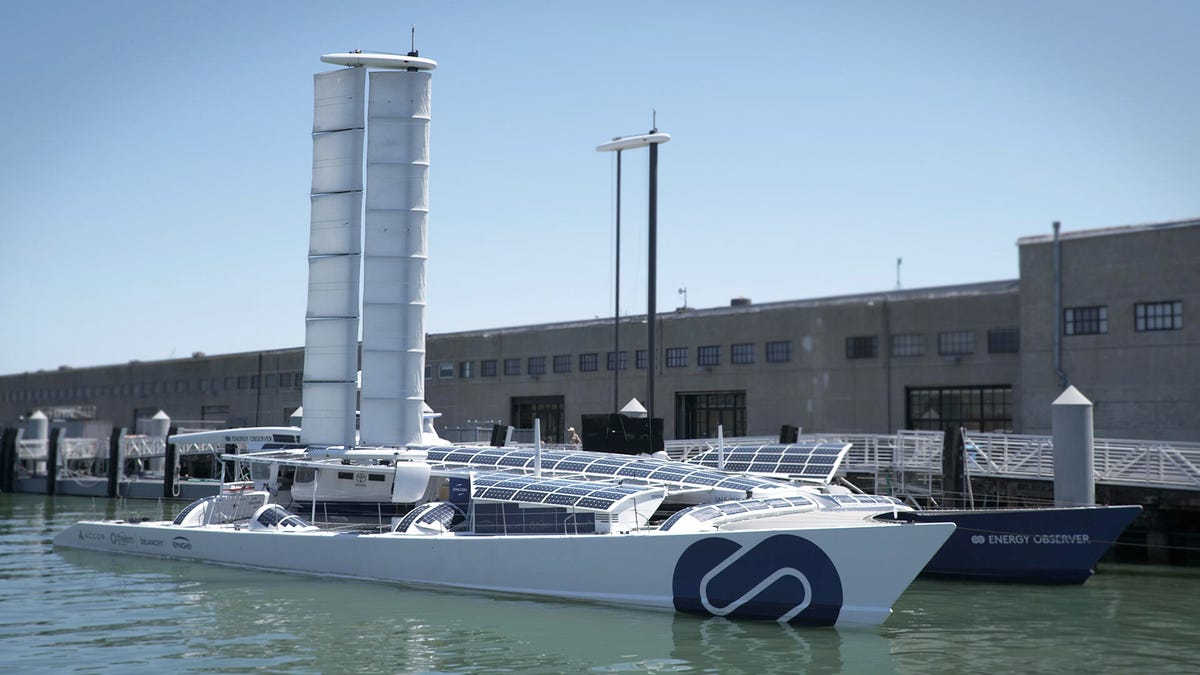Energy Observer: On board the world's first hydrogen-powered boat
The 100-foot, repurposed catamaran is sailing around the the world to prove that the most abundant element in the universe is key to building a cleaner future.

The hydrogen-powered Energy Observer moored on the San Francisco Bay.
Moored in the San Francisco Bay, the Energy Observer is nearly impossible to ignore. A nonstop flow of tourists walking the city's historic Embarcadero stop for selfies with the ship (even though most don't know what it is). I watch as I wait to board.
My tour of the 100-foot catamaran is a result of good or bad luck, depending on your point of view. The Energy Observer and its 10-person crew are on an unscheduled stop here due to weather, on their way from Southern California to Hawaii. The ship has been at sea since 2017, out to prove its technological tools in the harshest possible conditions.
"If they can survive here, they'll work really well on land." says Katie Nicolet, the ship's scientist. "The ultimate goal is to showcase that we can use renewable energies to navigate and go around the world" without any type of emissions.
Without a doubt the most striking feature of the catamaran are its 202 square meters of solar panels, covering the majority of its exposed surface. Most of the time they feed the batteries that power everything on board, from the engines to the kitchen appliances. "But on a day like today, when we drop anchor, we don't have engines (running); we're producing too much energy. So instead of wasting it, we're going to turn the excess energy into hydrogen." says Nicolet.
The Energy Observer is covered in 202 square meters of solar panels.
Using reverse osmosis, pumped-in seawater is converted to pure water that's then electrolyzed by the onboard batteries. The electrolyzation separates the water molecules into pure oxygen and hydrogen. The hydrogen is stored in eight tanks on the ship's wings. Nicolet says the tanks can store enough hydrogen to power the ship for six days. When the batteries run low and there's not enough sun, the hydrogen is used to create electricity using the same fuel cell found in the Toyota Mirai sedan.
The chemical process the fuel cell uses to create electricity also produces water and heat. The water is collected in tanks, and the heat is used to warm the cabin and for hot water.
Second only to the solar panels in terms of unusual features are the sails. Unlike with most sailboats, Nicolet says, engineers had to design them with a unique factor in mind: shade.
"Otherwise," she says, "we would have a big mast in the middle and half the ship would always be in the shade." That's not ideal when you're relying on the sun to keep the lights on. The sails, built to minimize shade, work more like airplane wings than traditional sails to generate forward momentum. Most of the time the ship is running in a hybrid mode, generating about half its power from the engines and half from the wind (though it can run by wind completely with about 15 knots of power).
Though a pilot is always at the helm when the ship is moving, the Energy Observer operates mostly autonomously.
Below deck you'll find six cabins, the lounge area that doubles as the crew's workspace, the kitchen and what Nicolet refers to as the brain of the ship. Similar to the display panel on a hybrid or electric car, this computer shows the crew everything, from how much power they're producing, to how much they just drained by making a cup of coffee. "We have an engineer with us at all times," Nicolet says. "And sometimes we have to ask him, Can we run the dishwasher? Can we have a hot meal tonight? Or are the batteries too low?"
Energy Observer and its crew next plan to sail to Hawaii, before heading to Tokyo to promote hydrogen-based energies at the summer Olympics. See more from my tour of the Energy Observer in the above video.

